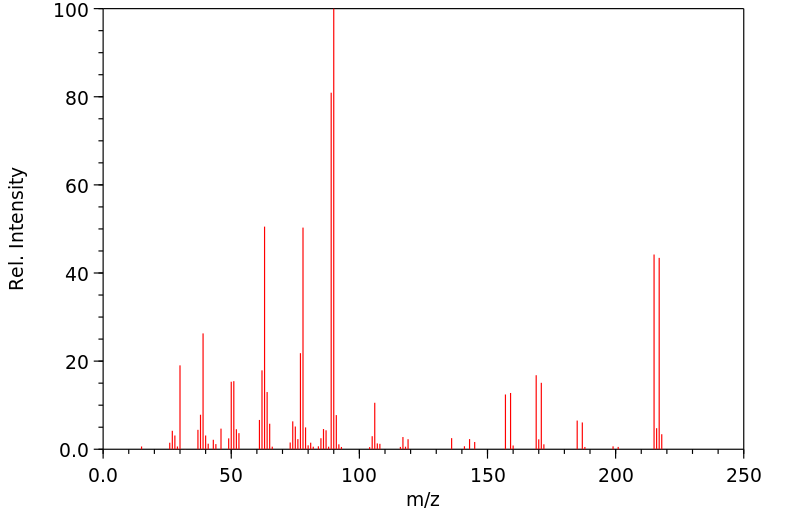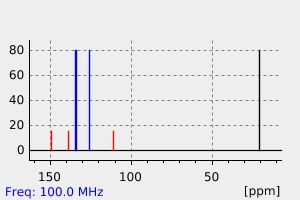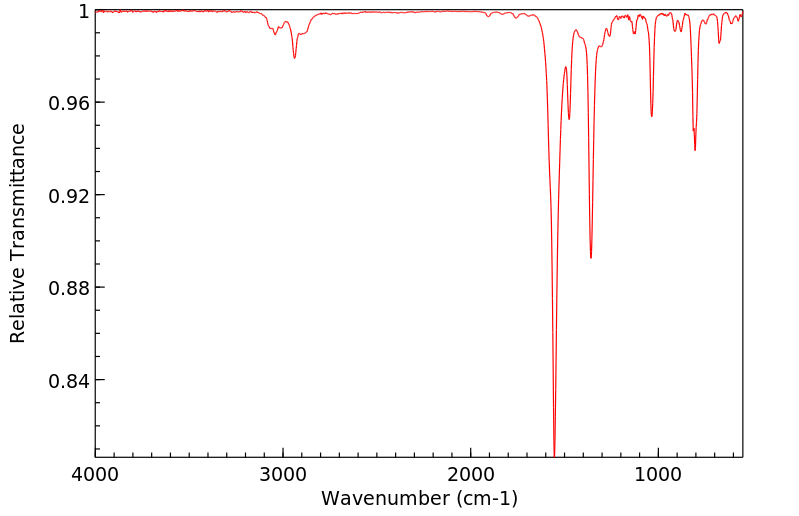4-溴-3-硝基甲苯 | 5326-34-1
-
物化性质
-
计算性质
-
ADMET
-
安全信息
-
SDS
-
制备方法与用途
-
上下游信息
-
文献信息
-
表征谱图
-
同类化合物
-
相关功能分类
-
相关结构分类
物化性质
-
熔点:31-33 °C (lit.)
-
沸点:151.5-152.5 °C/14 mmHg (lit.)
-
密度:1.578 g/mL at 25 °C (lit.)
-
闪点:>230 °F
-
稳定性/保质期:
在常温常压下保持稳定。
计算性质
-
辛醇/水分配系数(LogP):2.9
-
重原子数:11
-
可旋转键数:0
-
环数:1.0
-
sp3杂化的碳原子比例:0.142
-
拓扑面积:45.8
-
氢给体数:0
-
氢受体数:2
安全信息
-
危险等级:IRRITANT
-
危险品标志:Xn
-
安全说明:S22,S26,S36,S36/37,S36/37/39
-
危险类别码:R20/21/22,R36/37/38
-
WGK Germany:3
-
海关编码:2904909090
-
危险品运输编号:NONH for all modes of transport
-
危险性防范说明:P261,P305+P351+P338
-
危险性描述:H315,H319,H335
-
储存条件:避光,存放在阴凉干燥处,并密封保存。
SDS
: 4-Bromo-3-nitrotoluene
化学品俗名或商品名
1.2 鉴别的其他方法
无数据资料
1.3 有关的确定了的物质或混合物的用途和建议不适合的用途
仅供科研用途,不作为药物、家庭备用药或其它用途。
模块 2. 危险性概述
2.1 GHS分类
皮肤刺激 (类别2)
眼刺激 (类别2A)
特异性靶器官系统毒性(一次接触) (类别3)
2.2 GHS 标记要素,包括预防性的陈述
危害类型象形图
信号词 警告
危险申明
H315 造成皮肤刺激。
H319 造成严重眼刺激。
H335 可能引起呼吸道刺激。
警告申明
预防
P261 避免吸入粉尘/ 烟/ 气体/ 烟雾/ 蒸汽/ 喷雾。
P264 操作后彻底清洁皮肤。
P271 只能在室外或通风良好之处使用。
P280 穿戴防护手套/ 眼保护罩/ 面部保护罩。
措施
P302 + P352 如果在皮肤上: 用大量肥皂和水淋洗。
P304 + P340 如果吸入: 将患者移到新鲜空气处休息,并保持呼吸舒畅的姿势。
P305 + P351 + P338 如进入眼睛:用水小心清洗几分钟。如戴隐形眼镜并可方便地取出,取出
隐形眼镜。继续冲洗。
P312 如感觉不适,呼救解毒中心或医生。
P321 具体治疗(见本标签上提供的急救指导)。
P332 + P313 如发生皮肤刺激:求医/ 就诊。
P337 + P313 如仍觉眼睛刺激:求医/ 就诊。
P362 脱掉沾染的衣服,清洗后方可重新使用。
储存
P403 + P233 存放于通风良的地方。 保持容器密闭。
P405 存放处须加锁。
处理
P501 将内容物/ 容器处理到得到批准的废物处理厂。
2.3 其它危害物 - 无
模块 3. 成分/组成信息
3.1 物 质
: C7H6BrNO2
分子式
: 216.03 g/mol
分子量
成分 浓度
4-Bromo-3-nitrotoluene
-
化学文摘编号(CAS No.) 5326-34-1
EC-编号 226-203-6
模块 4. 急救措施
4.1 必要的急救措施描述
一般的建议
请教医生。 出示此安全技术说明书给到现场的医生看。
如果吸入
如果吸入,请将患者移到新鲜空气处。 如果停止了呼吸,给于人工呼吸。 请教医生。
在皮肤接触的情况下
用肥皂和大量的水冲洗。 请教医生。
在眼睛接触的情况下
用大量水彻底冲洗至少15分钟并请教医生。
如果误服
切勿给失去知觉者从嘴里喂食任何东西。 用水漱口。 请教医生。
4.2 最重要的症状和影响,急性的和滞后的
据我们所知,此化学,物理和毒性性质尚未经完整的研究。
4.3 及时的医疗处理和所需的特殊处理的说明和指示
无数据资料
模块 5. 消防措施
5.1 灭火介质
灭火方法及灭火剂
用水雾,耐醇泡沫,干粉或二氧化碳灭火。
5.2 源于此物质或混合物的特别的危害
碳氧化物, 氮氧化物, 溴化氢气
5.3 救火人员的预防
如必要的话,戴自给式呼吸器去救火。
5.4 进一步的信息
无数据资料
模块 6. 泄露应急处理
6.1 人员的预防,防护设备和紧急处理程序
使用个人防护设备。 防止吸入蒸汽、气雾或气体。 保证充分的通风。 将人员撤离到安全区域。
6.2 环境预防措施
不要让产物进入下水道。
6.3 抑制和清除溢出物的方法和材料
用惰性吸附材料吸收并当作危险废品处理。 存放在合适的封闭的处理容器内。
6.4 参考其他部分
丢弃处理请参阅第13节。
模块 7. 操作处置与储存
7.1 安全操作的注意事项
避免接触皮肤和眼睛。 防止吸入蒸汽和烟雾。
一般性的防火保护措施。
7.2 安全储存的条件,包括任何不兼容性
贮存在阴凉处。 容器保持紧闭,储存在干燥通风处。
打开了的容器必须仔细重新封口并保持竖放位置以防止泄漏。
7.3 特定用途
无数据资料
模块 8. 接触控制/个体防护
8.1 控制参数
最高容许浓度
没有已知的国家规定的暴露极限。
8.2 暴露控制
适当的技术控制
根据工业卫生和安全使用规则来操作。 休息以前和工作结束时洗手。
人身保护设备
眼/面保护
带有防护边罩的安全眼镜符合 EN166要求请使用经官方标准如NIOSH (美国) 或 EN 166(欧盟)
检测与批准的设备防护眼部。
皮肤保护
戴手套取 手套在使用前必须受检查。
请使用合适的方法脱除手套(不要接触手套外部表面),避免任何皮肤部位接触此产品.
使用后请将被污染过的手套根据相关法律法规和有效的实验室规章程序谨慎处理. 请清洗并吹干双手
所选择的保护手套必须符合EU的89/686/EEC规定和从它衍生出来的EN 376标准。
身体保护
防渗透的衣服, 防护设备的类型必须根据特定工作场所中的危险物的浓度和含量来选择。
呼吸系统防护
如危险性评测显示需要使用空气净化的防毒面具,请使用全面罩式多功能防毒面具(US)或ABEK型
(EN
14387)防毒面具筒作为工程控制的候补。如果防毒面具是保护的唯一方式,则使用全面罩式送风防
毒面具。 呼吸器使用经过测试并通过政府标准如NIOSH(US)或CEN(EU)的呼吸器和零件。
模块 9. 理化特性
9.1 基本的理化特性的信息
a) 外观与性状
形状: 液体
颜色: 黄色
b) 气味
无数据资料
c) 气味临界值
无数据资料
d) pH值
无数据资料
e) 熔点/凝固点
熔点/熔点范围: 31 - 33 °C - lit.
f) 起始沸点和沸程
151.5 - 152.5 °C 在 19 hPa - lit.
g) 闪点
113 °C - 闭杯
h) 蒸发速率
无数据资料
i) 可燃性(固体,气体)
无数据资料
j) 高的/低的燃烧性或爆炸性限度 无数据资料
k) 蒸气压
无数据资料
l) 相对蒸气密度
无数据资料
m) 相对密度
1.578 g/cm3 在 25 °C
n) 水溶性
无数据资料
o) 辛醇/水分配系数的对数值
无数据资料
p) 自燃温度
无数据资料
q) 分解温度
无数据资料
r) 粘度
无数据资料
模块 10. 稳定性和反应活性
10.1 反应性
无数据资料
10.2 化学稳定性
无数据资料
10.3 危险反应的可能性
无数据资料
10.4 避免接触的条件
无数据资料
10.5 不兼容的材料
强氧化剂强氧化剂, 强还原剂, 强酸, 强碱
10.6 危险的分解产物
其它分解产物 - 无数据资料
模块 11. 毒理学资料
11.1 毒理学影响的信息
急性毒性
无数据资料
皮肤腐蚀/刺激
无数据资料
严重眼损伤 / 眼刺激
无数据资料
呼吸道或皮肤过敏
无数据资料
生殖细胞诱变
无数据资料
致癌性
IARC:
此产品中没有大于或等于 0。1%含量的组分被 IARC鉴别为可能的或肯定的人类致癌物。
生殖毒性
无数据资料
特异性靶器官系统毒性(一次接触)
吸入 - 可能引起呼吸道刺激。
特异性靶器官系统毒性(反复接触)
无数据资料
吸入危险
无数据资料
潜在的健康影响
吸入 吸入可能有害。 引起呼吸道刺激。
摄入 如服入是有害的。
皮肤 如果通过皮肤吸收可能是有害的。 造成皮肤刺激。
眼睛 造成严重眼刺激。
接触后的征兆和症状
据我们所知,此化学,物理和毒性性质尚未经完整的研究。
附加说明
化学物质毒性作用登记: 无数据资料
模块 12. 生态学资料
12.1 毒性
无数据资料
12.2 持久存留性和降解性
无数据资料
12.3 生物积累的潜在可能性
无数据资料
12.4 土壤中的迁移
无数据资料
12.5 PBT 和 vPvB的结果评价
无数据资料
12.6 其它不利的影响
无数据资料
模块 13. 废弃处置
13.1 废物处理方法
产品
将剩余的和未回收的溶液交给处理公司。 联系专业的拥有废弃物处理执照的机构来处理此物质。
污染了的包装物
作为未用过的产品弃置。
模块 14. 运输信息
14.1 UN编号
欧洲陆运危规: - 国际海运危规: - 国际空运危规: -
14.2 联合国(UN)规定的名称
欧洲陆运危规: 无危险货物
国际海运危规: 无危险货物
国际空运危规: 无危险货物
14.3 运输危险类别
欧洲陆运危规: - 国际海运危规: - 国际空运危规: -
14.4 包裹组
欧洲陆运危规: - 国际海运危规: - 国际空运危规: -
14.5 环境危险
欧洲陆运危规: 否 国际海运危规 海运污染物: 否 国际空运危规: 否
14.6 对使用者的特别预防
无数据资料
模块 15 - 法规信息
N/A
模块16 - 其他信息
N/A
制备方法与用途
上下游信息
-
上游原料
中文名称 英文名称 CAS号 化学式 分子量 3-硝基甲苯 1-methyl-3-nitrobenzene 99-08-1 C7H7NO2 137.138 4-甲基-2-硝基苯胺 4-methyl-2-nitroaniline 89-62-3 C7H8N2O2 152.153 -
下游产品
中文名称 英文名称 CAS号 化学式 分子量 —— 4-bromo-3-nitrobenzyl alcohol 145547-97-3 C7H6BrNO3 232.034 4-溴-3-硝基苄溴 1-bromo-4-(bromomethyl)-2-nitrobenzene 326595-66-8 C7H5Br2NO2 294.93 4-溴-3,5-二硝基-甲苯 4-bromo-3,5-dinitro-toluene 857001-06-0 C7H5BrN2O4 261.032 4-溴-3-硝基苯甲酸 4-bromo-3-nitrobenzoic acid 6319-40-0 C7H4BrNO4 246.017 4-溴-3,5-二硝基苯甲酸 4-bromo-3,5-dinitrobenzoic acid 577-52-6 C7H3BrN2O6 291.015 —— 4-bromo-3,5-dinitro-benzoic acid ethyl ester 36749-39-0 C9H7BrN2O6 319.068 2-溴-5-甲基苯胺 2-bromo-5-methylaniline 53078-85-6 C7H8BrN 186.051
反应信息
-
作为反应物:描述:参考文献:名称:Jackson; Ittner, American Chemical Journal, 1897, vol. 19, p. 14摘要:DOI:
-
作为产物:描述:参考文献:名称:含氟的4-甲氧基甲基苄基高氯酸盐的合成及其杀虫活性摘要:为了研究含氟的4-甲氧基甲基苄基高氯酸酯的氟原子位置与杀虫活性之间的关系,合成了2-和3-氟-4-甲氧基甲基苄基(±)-顺式-高氯菊酯。测试了它们的杀虫活性,并讨论了标题化合物的氟效应。DOI:10.1016/s0022-1139(02)00148-3
文献信息
-
IRAK DEGRADERS AND USES THEREOF申请人:Kymera Therapeutics, Inc.公开号:US20190192668A1公开(公告)日:2019-06-27The present invention provides compounds, compositions thereof, and methods of using the same.本发明提供了化合物、其组合物以及使用这些化合物的方法。
-
BENZOFURAN-2-SULFONAMIDES DERIVATIVES AS CHEMOKINE RECEPTOR MODULATORS申请人:ALLERGAN, INC.公开号:US20130231338A1公开(公告)日:2013-09-05The present invention relates to novel benzofuran-2-sulfonamide derivatives, processes for preparing them, pharmaceutical compositions containing them and their use as pharmaceuticals as modulators of chemokine receptors.
-
Efficient one-pot transformation of aminoarenes to haloarenes using halodimethylisulfonium halides generated in situ作者:Woonphil Baik、Wanqiang Luan、Hyun Joo Lee、Cheol Hun Yoon、Sangho Koo、Byeong Hyo KimDOI:10.1139/v05-026日期:2005.3.1
Halodimethylsulfonium halide 1, which is readily formed in situ from hydrohaloic acid and DMSO, is a good nucleophilic halide. This activated nucleophilic halide rapidly converts aryldiazonium salt prepared in situ by the same hydrohaloic acid and nitrite ion to aryl chlorides, bromides, or iodides in good yield. The combined action of nitrite ion and hydrohaloic acid in DMSO is required for the direct transformation of aromatic amines, which results in the production of aryl halides within 1 h. Substituted compounds with electron-donating or -withdrawing groups or sterically hindered aromatic amines are also smoothly transformed to the corresponding aromatic halides. The only observed by-product is the deaminated arene (usually <7%). The isolated aryldiazonium salts can also be converted to the corresponding aryl halides using 1. The present method offers a facile, one-step procedure for transforming aminoarenes to haloarenes and lacks the environmental pollutants that usually accompany the Sandmeyer reaction using copper halides. Key words: aminoarenes, haloarenes, halodimethylsulfonium halide, halogenation, amination.
卤二甲基亚砜卤化物1是一种良好的亲核卤化物,可在现场由氢卤酸和二甲亚砜形成。这种活化的亲核卤化物迅速将由相同的氢卤酸和亚硝酸根在现场制备的芳基重氮盐转化为芳基氯化物、溴化物或碘化物,收率较高。在DMSO中,亚硝酸根和氢卤酸的联合作用是直接转化芳香胺的必要条件,从而在1小时内产生芳基卤化物。带有电子给体或吸引基团或有立体位阻的芳香胺的取代化合物也可顺利转化为相应的芳香卤化物。观察到的唯一副产物是去氨基芳烃(通常<7%)。孤立的芳基重氮盐也可以使用1转化为相应的芳基卤化物。该方法提供了一种简便的、一步法的程序,用于将氨基芳烃转化为卤代芳烃,并且不伴随通常伴随使用铜卤化物进行桑迈尔反应的环境污染物。关键词:氨基芳烃,卤代芳烃,卤二甲基亚砜卤化物,卤化,胺化。 -
[EN] NOVEL ANTIVIRAL COMPOUNDS<br/>[FR] NOUVEAUX COMPOSÉS ANTIVIRAUX申请人:PHARMARESOURCES SHANGHAI CO LTD公开号:WO2012065062A1公开(公告)日:2012-05-18The present invention relates to a compound of formula I: or a pharmaceutically acceptable salt thereof, wherein the symbols are as defined in the specification; a pharmaceutical composition comprising the same, a method for treating or preventing a viral infection such as HIV using the same.本发明涉及一种化合物I的化学式:或其药用可接受的盐,其中符号如规范中定义;包括相同化合物的药物组合物,以及使用该化合物治疗或预防病毒感染,如HIV的方法。
-
Validation of Phosphodiesterase-10 as a Novel Target for Pulmonary Arterial Hypertension via Highly Selective and Subnanomolar Inhibitors作者:Yi-You Huang、Yan-Fa Yu、Chen Zhang、Yiping Chen、Qian Zhou、Zhuoming Li、Sihang Zhou、Zhe Li、Lei Guo、Deyan Wu、Yinuo Wu、Hai-Bin LuoDOI:10.1021/acs.jmedchem.9b00224日期:2019.4.11phosphodiesterase-10 (PDE10) was reported to be a promising target for PAH based on the studies with a nonselective PDE inhibitor papaverine, but little progress has been made to confirm the practical application of PDE10 inhibitors. To validate whether PAH is ameliorated by PDE10 inhibition rather than other PDE isoforms, here we report an integrated strategy to discover highly selective PDE10 inhibitors as chemical肺动脉高压(PAH)导致肺血管阻力的病理性增加,导致右心衰竭和最终死亡。以前,基于对非选择性PDE抑制剂罂粟碱的研究,据报道磷酸二酯酶10(PDE10)是PAH的有希望的靶标,但在确认PDE10抑制剂的实际应用方面进展甚微。为了验证PAH是否可通过PDE10抑制而不是其他PDE亚型得到改善,在此我们报告了一项综合策略,以发现高选择性PDE10抑制剂作为化学探针。结构优化产生了PDE10抑制剂2b,具有亚纳摩尔亲和力和对其他PDE的> 45,000倍的良好选择性。PDE10-2b配合物的共晶体结构显示2b和Tyr693之间重要的H键相互作用。最后,化合物2b显着降低了PAH大鼠的动脉压,因此验证了PDE10作为新型抗PAH靶标的潜力。这些发现表明,PDE10抑制可能是PAH的可行治疗选择。
表征谱图
-
氢谱1HNMR
-
质谱MS
-
碳谱13CNMR
-
红外IR
-
拉曼Raman
-
峰位数据
-
峰位匹配
-
表征信息









